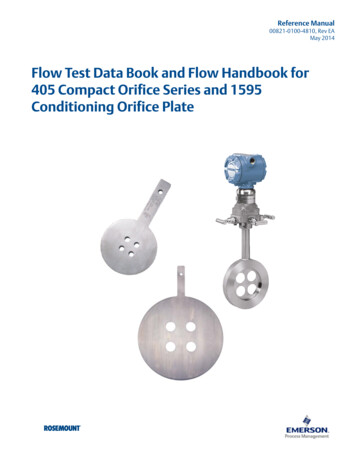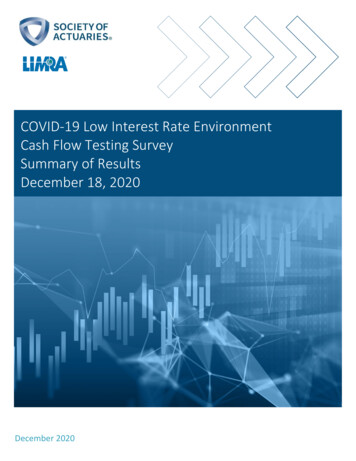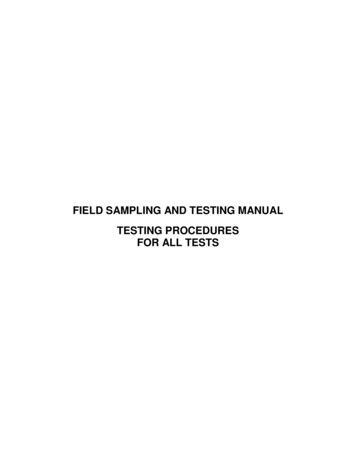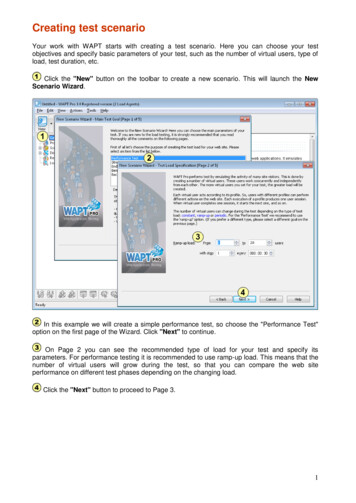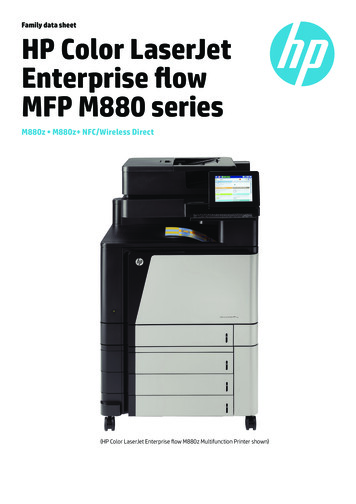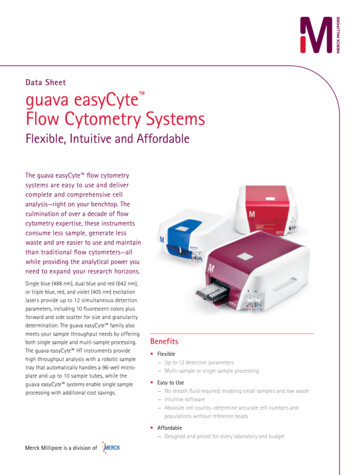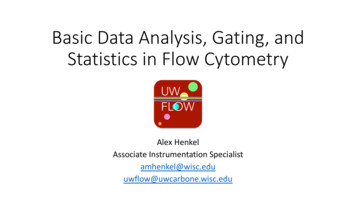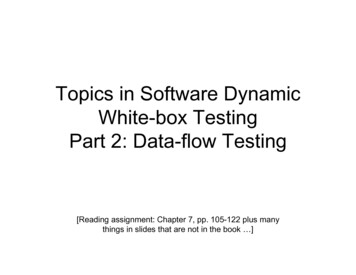
Transcription
Topics in Software DynamicWhite-box TestingPart 2: Data-flow Testing[Reading assignment: Chapter 7, pp. 105-122 plus manythings in slides that are not in the book ]
Data-Flow Testing Data-flow testing uses the controlflowgraph to explore the unreasonablethings that can happen to data (i.e.,anomalies). Consideration of data-flow anomaliesleads to test path selection strategiesthat fill the gaps between complete pathtesting and branch or statement testing.
Data-Flow Testing (Cont’d) Data-flow testing is the name given to a familyof test strategies based on selecting pathsthrough the program’s control flow in order toexplore sequences of events related to thestatus of data objects. E.g., Pick enough paths to assure that:– Every data object has been initialized prior to itsuse.– All defined objects have been used at least once.
Data Object Categories (d) Defined, Created, Initialized (k) Killed, Undefined, Released (u) Used:––(c) Used in a calculation(p) Used in a predicate
(d) Defined Objects An object (e.g., variable) is definedwhen it:– appears in a data declaration– is assigned a new value– is a file that has been opened– is dynamically allocated– .
(u) Used Objects An object is used when it is part of acomputation or a predicate. A variable is used for a computation (c) whenit appears on the RHS (sometimes even theLHS in case of array indices) of anassignment statement. A variable is used in a predicate (p) when itappears directly in that predicate.
Example: Definition and UsesWhat are the definitions and uses for the programbelow?1.2.3.4read (x, y);z x 2;if (z y)w x 1;else5.y y 1;6. print (x, y, w,z);
Example: Definition and Uses1.2.3.45.6.read (x, y);z x 2;if (z y)w x 1;elsey y 1;print (x, y, w, z);DefC-use P-usex, yzxz, ywxyyx, y,w, z
Static vs DynamicAnomaly Detection Static Analysis is analysis done onsource code without actually executingit.– E.g., Syntax errors are caught by staticanalysis.
Static vs DynamicAnomaly Detection (Cont’d) Dynamic Analysis is analysis done as aprogram is executing and is based onintermediate values that result from theprogram’s execution.– E.g., A division by 0 error is caught by dynamicanalysis. If a data-flow anomaly can be detected bystatic analysis then the anomaly does notconcern testing. (Should be handled by thecompiler.)
Anomaly Detection UsingCompilers Compilers are able to detect several data-flowanomalies using static analysis. E.g., By forcing declaration before use, acompiler can detect anomalies such as:– -u– ku Optimizing compilers are able to detect somedead variables.
Is Static Analysis Sufficient? Questions:Why isn’t static analysis enough?Why is testing required?Could a good compiler detect all dataflow anomalies? Answer: No. Detecting all data-flowanomalies is provably unsolvable.
Static Analysis Deficiencies Current static analysis methods areinadequate for:– Dead Variables: Detecting unreachablevariables is unsolvable in the general case.– Arrays: Dynamically allocated arrayscontain garbage unless they are initializedexplicitly. (-u anomalies are possible)
Static Analysis Deficiencies(Cont’d)– Pointers: Impossible to verify pointervalues at compile time.– False Anomalies: Even an obvious bug(e.g., ku) may not be a bug if the pathalong which the anomaly exists isunachievable. (Determining whether apath is or is not achievable is unsolvable.)
Data-Flow Modeling Data-flow modeling is based on thecontrol flowgraph. Each link is annotated with:– symbols (e.g., d, k, u, c, p)– sequences of symbols (e.g., dd, du, ddd) that denote the sequence of dataoperations on that link with respect tothe variable of interest.
Simple Path Segments A Simple Path Segment is a pathsegment in which at most one node isvisited twice.– E.g., (7,4,5,6,7) is simple. Therefore, a simple path may or maynot be loop-free.
Loop-free Path Segments A Loop-free Path Segment is a pathsegment for which every node is visitedat most once.– E.g., (4,5,6,7,8,10) is loop-free.– path (10,11,4,5,6,7,8,10,11,12) is not loopfree because nodes 10 and 11 are visitedtwice.
du Path Segments A du Path is a path segment such thatif the last link has a use of X, then thepath is simple and definition clear.
def-use Associations A def-use association is a triple (x, d, u,), where:x is a variable,d is a node containing a definition of x,u is either a statement or predicate nodecontaining a use of x,and there is a sub-path in the flow graph from d to uwith no other definition of x between d and u.
Example: Def-UseAssociations123z x 2z y546Some Def-Use Associations:(x, 1, 2), (x, 1, 4), (y, 1, (3,t)), (y, 1, (3,f)), (y, 1, 5), (z, 2, (3,t)),.FTw x 1read (x, y)y y 1print (x,y,w,z)
Example: Def-UseAssociationsWhat are all the def-use associations for the programbelow?read (z)x 0y 0if (z 0){x sqrt (z)if (0 x && x 5)y f (x)elsey h (z)}y g (x, y)print (y)
Example: Def-UseAssociationsdef-use associations for variable z.read (z)x 0y 0if (z 0){x sqrt (z)if (0 x && x 5)y f (x)elsey h (z)}y g (x, y)print (y)
Example: Def-UseAssociationsread (z)def-use associations for variablex 0x.y 0if (z 0){x sqrt (z)if (0 x && x 5)else}y g (x, y)print (y)y f (x)y h (z)
Example: Def-UseAssociationsread (z)def-use associations for variable y.x 0y 0if (z 0){x sqrt (z)if (0 x && x 5)y f (x)elsey h (z)}y g (x, y)print (y)
Definition-Clear Paths A path (i, n1, ., nm, j) is called a definition-clear pathwith respect to x from node i to node j if it containsno definitions of variable x in nodes (n1, ., nm , j) . The family of data flow criteria requires that the testdata execute definition-clear paths from each nodecontaining a definition of a variable to specifiednodes containing c-use and edges containing p-useof that variable.
Data-Flow Testing Strategies All du Paths (ADUP) All Uses (AU) Others not covered in this course
All du Paths Strategy (ADUP) ADUP is one of the strongest data-flowtesting strategies. ADUP requires that every du path fromevery definition of every variable toevery use of that definition be exercisedunder some test All du Paths Strategy(ADUP).
An example: All-du-pathsWhat are all the du-paths in the following program ?read (x,y);for (i 1; i 2; i )print (“hello”);Sa;if (y 0)S b;elseprint (x);
An example: All-du-paths123Tprint(“hello”)46FTread (x, y)i 1print xSbi 278F5Sa9i i 16y oy o
Example: pow(x,y)/* pow(x,y)This program computes x to the power of y, where x and y are integers.INPUT: The x and y values.OUTPUT: x raised to the power of y is printed to stdout.*/1void pow (int x, y)2{3float z;4int p;b5if (y 0)6p 0 – y;afd7else p y;15898z 1.0;9while (p ! 0)c10{e11z z * x;12p p – 1;13}14if (y 0)15z 1.0 / z;16printf(z);17}g1416hi17
Example: pow(x,y)du-Path for Variable x/* pow(x,y)This program computes x to the power of y, where x and y are integers.INPUT: The x and y values.OUTPUT: x raised to the power of y is printed to stdout.*/1void pow (int x, y)2{3float z;4int p;b5if (y 0)6p 0 – y;afd7else p y;15898z 1.0;9while (p ! 0)c10{e11z z * x;12p p – 1;13}14if (y 0)15z 1.0 / z;16printf(z);17}g1416hi17
Example: pow(x,y)du-Path for Variable x/* pow(x,y)This program computes x to the power of y, where x and y are integers.INPUT: The x and y values.OUTPUT: x raised to the power of y is printed to stdout.*/1void pow (int x, y)2{3float z;4int p;b5if (y 0)6p 0 – y;afd7else p y;15898z 1.0;9while (p ! 0)c10{e11z z * x;12p p – 1;13}14if (y 0)15z 1.0 / z;16printf(z);17}g1416hi17
Example: pow(x,y)du-Path for Variable y/* pow(x,y)This program computes x to the power of y, where x and y are integers.INPUT: The x and y values.OUTPUT: x raised to the power of y is printed to stdout.*/1void pow (int x, y)2{3float z;4int p;b5if (y 0)6p 0 – y;afd7else p y;15898z 1.0;9while (p ! 0)c10{e11z z * x;12p p – 1;13}14if (y 0)15z 1.0 / z;16printf(z);17}g1416hi17
Example: pow(x,y)du-Path for Variable y/* pow(x,y)This program computes x to the power of y, where x and y are integers.INPUT: The x and y values.OUTPUT: x raised to the power of y is printed to stdout.*/1void pow (int x, y)2{3float z;4int p;b5if (y 0)6p 0 – y;afd7else p y;15898z 1.0;9while (p ! 0)c10{e11z z * x;12p p – 1;13}14if (y 0)15z 1.0 / z;16printf(z);17}g1416hi17
Example: pow(x,y)du-Path for Variable y/* pow(x,y)This program computes x to the power of y, where x and y are integers.INPUT: The x and y values.OUTPUT: x raised to the power of y is printed to stdout.*/1void pow (int x, y)2{3float z;4int p;b5if (y 0)6p 0 – y;afd7else p y;15898z 1.0;9while (p ! 0)c10{e11z z * x;12p p – 1;13}14if (y 0)15z 1.0 / z;16printf(z);17}g1416hi17
All Uses Strategy (AU) AU requires that at least one path from everydefinition of every variable to every use ofthat definition be exercised under some test. Hence, at least one definition-clear path fromevery definition of every variable to every useof that definition be exercised under sometest. Clearly, AU ADUP.
Effectiveness of Strategies Ntafos compared Random, Branch,and All uses testing strategies on 14Kernighan and Plauger programs. Kernighan and Plauger programs are aset of mathematical programs withknown bugs that are often used toevaluate test strategies. Ntafos conducted two experiments:
Results of 2 of the 14Ntafos ExperimentsStrategyMean Numberof Test CasesPercentage ofBugs FoundRandom3593.7Branch3.891.6All Uses11.396.3StrategyMean Numberof Test CasesPercentage ofBugs FoundRandom10079.5Branch3485.5All Uses8490.0
Data-Flow Testing Tips Resolve all data-flow anomalies. Try to do all data-flow operations on avariable within the same routine (i.e.,avoid integration problems). Use strong typing and user definedtypes when possible.
Data-Flow Testing Tips(Cont’d) Use explicit (rather than implicit)declarations of data when possible. Put data declarations at the top of theroutine and return data objects at thebottom of the routine.
Summary Data are as important as code. Define what you consider to be a dataflow anomaly. Data-flow testing strategies span thegap between all paths and branchtesting.
Summary AU has the best payoff for the money.It seems to be no worse than twice thenumber of required test cases forbranch testing, but the results aremuch better. Path testing with Branch Coverageand Data-flow testing with AU is a verygood combination.
You now know data flow testing du coverage AU coverage
–False Anomalies: Even an obvious bug (e.g., ku) may not be a bug if the path along which the anomaly exists is unachievable. (Determining whether a path is or is not achievable is unsolvable.) Data-Flow Modeling Data-flow modeling is based on the control flowgraph. Each link is annotated with: –symbols (e.g., d, k, u, c, p) –sequences of symbols (e.g., dd, du, ddd) that denote .
